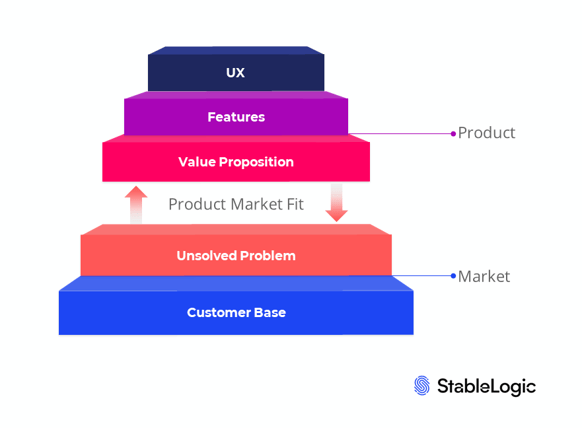Whether it’s an entirely new idea or the digital transformation of an existing solution, mobile application development can make or break a business. In this guide we go through the key steps to creating a mobile app and offer our tips on how to make one that stands among the giants.
Developing a mobile app involves a unique blend of business strategy and technical ability. Without a clear understanding of the problem you’re solving, achieving product-market fit will prove a challenge. Similarly, without expertise in the development process, you may find your app failing to deliver on the vision set out. Achieving success requires harmony between these two objectives; where the apps that combine efficiency and innovation are the ones to succeed.
The key steps to creating a mobile app
Ensuring the success of your app means paying close attention to each part of the process. As we examine each one, let’s consider the example of Uber, which quickly became the de facto app for getting a taxi.
1. Defining and validating the problem
It might seem obvious, but addressing the problem that your app is going to solve remains the key first crucial step of creation. It is essential to spell it out and ensure it resonates with a real issue; the words of Seth Godin ring true - “Don’t find customers for your products, find products for your customers”. This involves engaging with real-world problems to gain an understanding of the pain points you’re addressing and how a solution can alleviate them. Setting clear objectives, perhaps in the form of KPIs (key performance indicators), can allow you to stay on track during the app development steps.
In the case of Uber, the founders were initially struck by the personal experiences of the difficulty and high expense of hiring a taxi. During the era of smartphones and digitalisation, the process of acquiring a taxi had yet to be disrupted. They saw an opportunity to make getting a taxi easier by accessing the availability of smartphones and the growing gig economy. How might Uber have ensured they stayed on their objective through KPIs? Looking at the number of people who used taxis regularly, and how many they expected would prefer a simpler method, could have been a key metric.
2. Research and planning
The next stage involves looking at both the current market and defining the features needed for a MVP (minimum viable product).
Regarding the market, you first need to understand how you will achieve product-market fit (PMF). If there is competition in the market, this gives you validation that there is indeed a problem to be solved, and looking at the features of competitors should inform your own design.
If there isn’t competition, it could either be that you’ve struck gold and are the first one to recognise it, or you’re at a dead end which has already been explored. Looking further into the market and the target audience can help you discern which. Rather than reinventing the wheel, explore how you might look at the problem in a different way. 
Product market fit is a synergy between knowing your market and creating a product that addresses it
Secondly, this stage is also about defining the key features of the app which will be needed for it to address the problem outlined. Apps often increase in the number of available features over time, but enabling it to carry out its core function should be the first key focus.
In the case of Uber, the founders spotted a gap in the market for a centralised form of a digital cab-hailing service. Widespread mobile technology would mean people could access the app from anywhere and wouldn’t have to seek out the phone number or website of the specific operator in a city. People with cars available would be able to join the gig economy in providing their services. Essentially, there was already the labour, infrastructure and market demand needed to make it happen, it just needed an app to connect them all together.
3. Design
With the key features decided and the market research providing validation and inspiration, it’s time to move on to design. Ensuring the UX has a seamless feel with easy navigation is an important guiding principle. You may create a sketch of the wireframe that contains the essentials feature of your app. There should be a clear workflow of how each central feature functions, as well as the layout of each page of the application. Say you’re an e-commerce company, the entire process of adding items to a cart and checking out would need to be mapped out, with every possibility of behaviour taken into account (removing items, changing size etc).
Uber needed to look at the central features of requesting and accepting rides, tracking drivers and processing payments. With the aim of replacing other taxi services with a simpler model, they had an emphasis on creating an easy-to-use app.
.jpg?width=443&height=295&name=pexels-picjumbocom-196646%20(1).jpg)
The design stage involves both stylistic and strategic choices
4. Development
Once the design is in place, you can begin the fourth of the app development steps. One of the key parts of development involves creating the database, which literally refers to the data needed for the app to function. How this is stored and managed depends on the type of data and function. In the case of Uber, they required a robust and scalable database, due to the vast amount of data captured by rides, users, drivers and payments.
The development is then usually structured into front-end and back-end coding, where setting milestones of development can better ensure successful delivery. The Agile development cycle has become a popular methodology which, as described by Atlassian1, involves “breaking the project into phases and emphasizes continuous collaboration and improvement.” Regarding the development of an app, an agile methodology can allow for more adaptability as you face challenges and change.
5. Testing and quality assurance
While your application may look pretty and have the key features in place, oversights and bugs are likely to crop up. This is not an error or failure, but a typical part of a normal development cycle.
Testing each feature continuously to smooth out bugs and flaws, as well as ensuring that the outcomes are of consistently high quality is arguably the most important stage. Over the years, an untold number of applications have had so many glitches and problems at launch that it killed them off from the get-go. A well-functioning app instils trust and reliability as part of your brand, rather than tarnishing it and introducing higher costs in patching it up.
You might also like: How to Avoid Cloud Migration Pitfalls
6. Hosting and deployment
Even when an app has been tested to satisfaction, the next step requires determining how it will be hosted and deployed. It first needs to meet the requirements of the stores which it will be downloaded from, e.g. the Apple Store and Google Play Store. If, for example, an app is under-provisioned in terms of the servers needed for it to handle requests at launch, then it might crash. Issues across scalability, security, server configuration and latency to name just a few will determine the best deployment of your app.
Uber was initially only released in San Francisco, before gaining traction and expanding globally. Starting smaller can be an important phase in creating sustainable and manageable growth.
7. Maintenance and improvement
The last of the mobile application development steps involves continuous improvement and the introduction of new features. Eradicating bugs requires tracking the app’s functionality, and driving growth of the app might require thinking about how else your app can provide utility. Uber did not stop with just taxis. First, they introduced more types of taxis to suit different needs, and eventually, they would move on to food delivery as well. While remaining the de facto app for getting a taxi, they would also take advantage of new markets and revenue streams.

Using analytics to monitor your app after launch can help improve performance
Advice from StableLogic Labs
While that framework provides a simple guide to the mobile application development steps, creating one that will truly stand out requires a little extra knowledge. Ultimately, the best apps strike the balance between efficiency and innovation. This often causes stakeholders to decide between building each part of the app from the ground up or using pre-built solutions.
Things like tools, libraries and frameworks can be imported for both ease and their tested assurance in quality. For example, Uber would have needed location services within their app to track the locations of users and drivers. Rather than creating their own version of these, using a pre-made solution would have saved time and ensured reliable location tracking.
However, apps that are only made up of pre-built parts are unlikely to truly disrupt anything or stand out from the other solutions. Creating your own unique features requires greater expertise, but it’s what will ultimately separate you from the competition.
Ready to develop your app?
At StableLogic Labs, we specialise in mobile application development that gives you a competitive advantage. With over 30 years of experience in the technology sector, our development team at StableLogic Labs offers custom development services that will set you apart from your competitors. Talk to our team today to begin your journey.
1. https://www.atlassian.com/agile
%20(1).gif?width=229&height=128&name=March%20Assets%20(500%20x%20280%20px)%20(1).gif)
%20(2).gif?width=227&height=127&name=March%20Assets%20(500%20x%20280%20px)%20(2).gif)